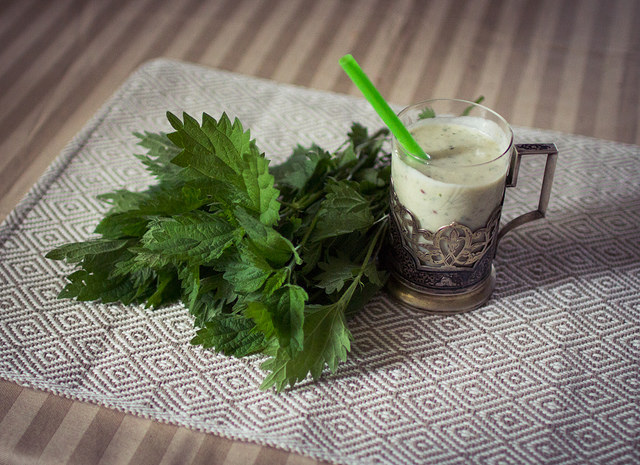Stinging nettle (Urtica dioica) is one of the most versatile herbs. It has long been known for its excellent healing properties, and it is used during fasting periods and in detoxification cures.

Maria Treben once remarked that if humanity realized the extent of the healing power of nettle, they would produce nothing but nettles. Perhaps nettle is not a miracle plant, but it is becoming an ever clearer fact that it has a huge impact in the service of our health. Discover and use nettle yourself!
Active ingredients in nettle
Nettle leaves and roots
Nettle leaves and roots contain flavonoids, cinnamic acids, minerals, ascorbic acid and formic acid. The stinging hairs contain acetylcholine, histamine and serotonin. The root contains sterols, lignans and polysaccharide protein polymer.
Collecting nettle
Collect nettle that grows in a clean environment, away from busy roads. The above-ground part of the plant can be collected from early spring until late autumn. Try to collect the plants around times when there is a full moon. Pick off the end of the shoots and the fresh leaves. The roots can be collected throughout the year, during new moon if possible. You should use gloves to protect your hands.
The medicinal effects of nettle
- The seeds, shoots, leaves and roots can be used fresh or dried, in water or wine infusions and as cooked food.
- Nettle has heating, diuretic, detoxifying, anti-rheumatic and blood cleansing effects, it stimulates the production of red blood cells, increases blood pressure, stimulates digestion and has a general strengthening effect.
- Due to its high vitamin content, nettle is suitable to treat periodontal inflammation and scurvy caused by vitamin deficiency.
- In cases of an underactive thyroid, constant feeling of cold, dullness or a weakened immune system, make nettle infusion and drink two cups a day for two weeks.
- Nettle strengthens the stomach and makes it more resistant. It is recommended for reducing blood sugar, and it naturally stimulates the pancreas.
- Nettle is also very effective in cases of iron deficiency and anemia. Nettle infusion made from fresh shoots (2 cups per day) will prove very useful. Drink one cup of the infusion in the morning on an empty stomach.
- Infusion made from nettle roots cures extreme, pathological anemia, especially if during the treatment period (3-4 weeks) the patient also drinks raw beet juice and apples flavored with honey and lemon once a day.
- Nettle reduces blood cholesterol levels, and it detoxifies and eliminates harmful substances deposited in the body. It cleanses the kidneys and the body fluids including the lymphatic system as well. It is recommended that persons prone to kidney and bladder stone formation drink nettle tea to cleanse their kidneys, and to remove and prevent kidney sand and stones.
- Nettle also strengthens nails, prevents hair loss and dandruff, and is excellent in treating greasy hair.
- Due to its warming and catarrh-reducing effect, nettle infusion facilitates breathing, and it is useful in cases of bronchitis. It is very effective if the root is cooked in wine and is consumed regularly 1-2 times a day. This treatment reduces the symptoms of allergic rhinitis as well.
- Nettle infusion is useful when used as poultice in the treatment of rashes and acne.
- Nettle tincture is excellent in treating rheumatic diseases and stimulating hair growth; it also inhibits the grease production of the scalp and prevents dandruff.
- The pressed juice of nettle heals insect bites and dog bites. It also strengthens the muscles, enhances circulation, and has a warming effect. It stimulates the nervous system, so persons suffering from dullness can also benefit from the effects of nettle juice. On the other hand, it shouldn’t be administered in states of nervousness or emotional instability.
- In cases of rheumatism and gout, consume nettle infusion 1-2 times daily for 3-4 weeks, and stimulate the patient’s sick body parts by gently hitting it with a fresh plant. In this case, the active ingredients in nettle hairs cause heating, reddening of the skin and swelling of the skin tissue due to the rush of blood to the area, and the inflammation and rheumatic pain subsides from the inside. Don’t expose the skin to cold water at this time, as in this case a burning sensation will be the result.
- Nettle infusion increases the strength of menstruation, which is occasionally beneficial due to the cleansing effect.
- In a pregnancy, due to a predisposition to spasms, it is not advised to consume nettle. On the other hand, nettle is suitable to increase milk production during nursing.
- Nettle root infusion can be applied successfully in case of enlargement of the prostate; however, it is not recommended in cases of acute inflammation.

How to use nettle
- Nettle tea
Place approximately 2 tablespoons of dried nettle leaves into a mug. You can use the same amount of fresh shoots as well. Boil up 300-400 ml drinking water, scald the leaves, and cover the mug immediately. Wait for 10-15 minutes to allow the active ingredients to fully dissolve in the water, then filter (preferably with a plastic filter), flavor with honey and drink.
- Compress and hair mask
This version is prepared similarly to an infusion, but in larger doses. It is ideal to use double the amount than in an infusion.
Boil up some water, scald the leaves, allow the concoction to cool and then rub it into the hair, wait for 5-10 minutes, and rinse it out. Repeat 2-3 times a week.
If you use nettle in a compress, place it on the area to be treated and leave it on for 10-15 minutes. Repeat several times.
- Sitting bath
Fill a bath with water at desired temperature. Stir in the nettle infusion, using 20-30 grams of nettles in a tub of water. Sit in the bath for 15-20 minutes.
- Nettle juice
You can make fresh nettle using a juicer: squeeze out the juice of a small bowlful of fresh nettle shoots and mix with a glass of water. Drink the resulting juice in two doses before meals. Nettle juice treats eczema and psoriasis.
- Allergy test
It is possible for nettle infusion to cause mild allergic reactions. Sip 1-2 mouthfuls of the tea and wait for 3-4 minutes. If you don’t feel any tingling, itching sensation in your throat and mouth, you can feel free to enjoy the infusion. To check for possible skin reactions, rub a small amount of the infusion on the inside of your forearm and wait for 5-10 minutes. If no redness, itching or rash appears, it is safe for you to use the infusion.

Warning
Nettle is not suitable to treat edema caused by established heart or kidney disease.
Never drink any kind of nettle preparation for more than six weeks; have a six-week break instead. Silica, an active ingredient contained in nettle gets deposited in the kidneys and may cause kidney stone or sand. Also, never drink more than 3-5 cups of nettle infusion per day. If you drink it in excess, the result can be allergies, stomach problems and skin burns, and instead of a diuretic effect, stagnant urine or even a choking reaction can be the result.
Nettle is not only useful in infusions, but it can also be incorporated into daily meals.
Nettle and bone soup recipe
Cook a good, strong soup stock out of beef and pork bones (approx. 2.5 l) in salted water. Sauté a chopped onion (1 medium head) until pale yellow. Before the onion is fully cooked, sprinkle a little flour on it, stirring continuously. When the flour turns the same color as the onions, pour in a little stock and then stir the onions into the soup. Add 100 g of chopped nettle leaves per person to the soup and continue to cook for 5 minutes. Before serving, slowly add a raw scrambled egg to the soup, and thicken with cream. Place bread cubes fried in butter into the serving bowls before dishing out the soup.
